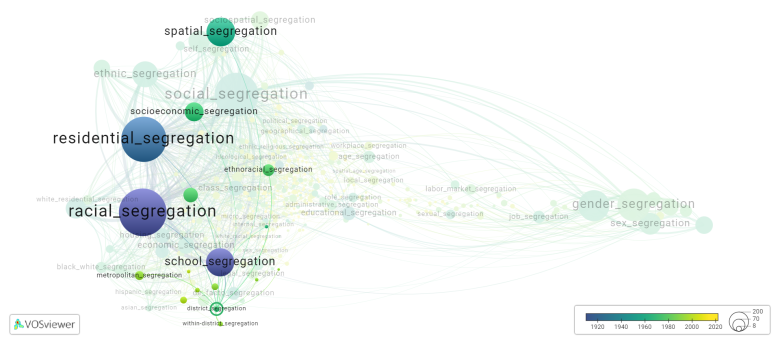District segregation
Date and country of first publication[1]
1979
United States
Definition
District segregation refers to the division of a city or region into separate neighborhoods or districts based on race, ethnicity, income level, or other social factors. This segregation can occur through various mechanisms, such as discriminatory housing practices, racial and economic disparities, or zoning policies.
District segregation can have significant implications for the residents of these neighborhoods. It can lead to disparities in access to resources and opportunities, such as quality education, healthcare, employment, and public services. Segregated districts often have higher levels of crime, poverty, and limited social mobility.
The historical roots of district segregation can be traced back to discriminatory practices such as redlining, which designated certain areas as "hazardous" or "undesirable" for investment based on racial composition. These practices have contributed to the perpetuation of racial and economic inequalities in many cities.
Efforts to address district segregation include legal protections against housing discrimination, affordable housing initiatives, and policies that promote neighborhood diversity and inclusion. Some cities have also implemented programs to revitalize disadvantaged neighborhoods and promote economic opportunities. However, despite these efforts, district segregation remains a persistent issue in many cities around the world.
See also
Related segregation forms
District segregation is frequently discussed in the literature with the following segregation forms:
school segregation, metropolitan segregation, racial segregation, within-district segregation, ethnoracial segregation, residential segregation, multischool racial segregation, metropolitan school segregation, public school segregation, spatial segregation, socioeconomic segregation, income segregation, hispanic white segregation, school district segregation

This visualization is based on the study The Multidisciplinary Landscape of Segregation Research.
For the complete network of interrelated segregation forms, please refer to:
References
Notes
- ↑ Date and country of first publication as informed by the Scopus database (December 2023).
District segregation appears in the following literature
Wurdock C. (1979). Public school resegregation after desegregation: Some preliminary findings. Sociological Focus, 12(4), 263-274. https://doi.org/10.1080/00380237.1979.10570352
Reardon S.F., Yun J.T., Eitle T.M. (2). The changing structure of school segregation: Measurement and evidence of multiracial metropolitan area school segregation, 1989 1995. Demography, 37(3), 351-364. Duke University Press.https://doi.org/10.2307/2648047
Reardon S.F., Yun J.T., Eitle T.M. (2). The changing structure of school segregation: Measurement and evidence of multiracial metropolitan area school segregation, 1989 1995. Demography, 37(3), 351-364. Duke University Press.https://doi.org/10.2307/2648047
Reardon S.F., Yun J.T. (2001). Suburban racial change and suburban school segregation, 1987 95. Sociology of Education, 74(2), 79-101. American Sociological Association.https://doi.org/10.2307/2673164
Eitle D., McNulty Eitle T. (2003). Segregation and School Violence. Social Forces, 82(2), 589-615. Oxford University Press.https://doi.org/10.1353/sof.2004.0007
Renzulli L.A. (2006). District segregation, race legislation, and black enrollment in charter schools. Social Science Quarterly, 87(3), 618-637. https://doi.org/10.1111/j.1540-6237.2006.00400.x
McCulloch A. (2007). The changing structure of ethnic diversity and segregation in England, 1991 2001. Environment and Planning A, 39(4), 909-927. https://doi.org/10.1068/a37349
McCulloch A. (2007). The changing structure of ethnic diversity and segregation in England, 1991 2001. Environment and Planning A, 39(4), 909-927. https://doi.org/10.1068/a37349
Eitle D., Eitle T.M. (201). Public school segregation and juvenile violent crime arrests in metropolitan areas. Sociological Quarterly, 51(3), 436-459. https://doi.org/10.1111/j.1533-8525.2010.01181.x
Eitle D., Eitle T.M. (201). Public school segregation and juvenile violent crime arrests in metropolitan areas. Sociological Quarterly, 51(3), 436-459. https://doi.org/10.1111/j.1533-8525.2010.01181.x
Zhang C.H., Walker M.A. (2012). School segregation in Jefferson county and the affiliated louisville metropolitan area, USA. Journal of Maps, 8(4), 379-385. https://doi.org/10.1080/17445647.2012.750251
Holme J.J., Finnigan K.S. (2013). School diversity, school district fragmentation and metropolitan policy. Teachers College Record, 115(11), -. Teachers College, Columbia University.https://doi.org/
Richards M.P. (2014). The Gerrymandering of School Attendance Zones and the Segregation of Public Schools: A Geospatial Analysis. American Educational Research Journal, 51(6), 1119-1157. SAGE Publications Inc..https://doi.org/10.3102/0002831214553652
Richards M.P., Stroub K.J. (2014). The fragmentation of metropolitan public school districts and the segregation of American schools: A longitudinal analysis. Teachers College Record, 116(12), -. Teachers College, Columbia University.https://doi.org/
Finnigan K.S., Holme J.J., Orfield M., Luce T., Diem S., Mattheis A., Hylton N.D. (2015). Regional Educational Policy Analysis: Rochester, Omaha, and Minneapolis’ Inter District Arrangements. Educational Policy, 29(5), 780-814. SAGE Publications Inc..https://doi.org/10.1177/0895904813518102
Finnigan K.S., Holme J.J., Orfield M., Luce T., Diem S., Mattheis A., Hylton N.D. (2015). Regional Educational Policy Analysis: Rochester, Omaha, and Minneapolis’ Inter District Arrangements. Educational Policy, 29(5), 780-814. SAGE Publications Inc..https://doi.org/10.1177/0895904813518102
Davis T., Bhatt R., Schwarz K. (2015). School segregation in the era of accountability. Social Currents, 2(3), 239-259. SAGE Publications Inc..https://doi.org/10.1177/2329496515589852
Owens A., Reardon S.F., Jencks C. (2016). Income Segregation Between Schools and School Districts. American Educational Research Journal, 53(4), 1159-1197. SAGE Publications Inc..https://doi.org/10.3102/0002831216652722
Owens A. (2016). Inequality in Children’s Contexts: Income Segregation of Households with and without Children. American Sociological Review, 81(3), 549-574. American Sociological Association.https://doi.org/10.1177/0003122416642430
Logan J.R., Zhang W., Oakley D. (2017). Court orders, white flight, and school district segregation, 1970 2010. Social Forces, 95(3), 1049-1075. Oxford University Press.https://doi.org/10.1093/sf/sow104
Sosina V.E., Weathers E.S. (2019). Pathways to Inequality: Between District Segregation and Racial Disparities in School District Expenditures. AERA Open, 5(3), -. SAGE Publications Inc..https://doi.org/10.1177/2332858419872445
Marcotte D.E., Dalane K. (2019). Socioeconomic Segregation and School Choice in American Public Schools. Educational Researcher, 48(8), 493-503. SAGE Publications Inc..https://doi.org/10.3102/0013189X19879714
Richards M.P., Stroub K.J. (202). Metropolitan public school district segregation by race and income, 2000 2011. Teachers College Record, 122(5), 21-41. Teachers College, Columbia University.https://doi.org/
Richards M.P., Stroub K.J. (202). Metropolitan public school district segregation by race and income, 2000 2011. Teachers College Record, 122(5), 21-41. Teachers College, Columbia University.https://doi.org/
